
Brake fluid is a liquid that works on the vehicle's braking system. When you press the brake pedal, this fluid creates hydraulic pressure to move the brake calipers, squeezing the brake pads against the brake rotors. This movement slows the vehicle.
The brake fluid travels through the car's braking system via brake lines that connect the brake pedal to many related components. The brake fluid reservoir sits under the hood.
Brake fluid is made to withstand high temperatures and maintain consistency. Over time, it can absorb moisture and become contaminated. Therefore, it needs regular checks and occasional replacements to keep working correctly.
What happens when the brake fluid is low?
Low brake fluid can compromise braking efficiency. A lack of brake fluid weakens the braking system since there will be low hydraulic pressure. The brake fluid requires a certain amount to work correctly, and anything below that weakens the brake components.
In addition, a low brake fluid level may indicate a leak in the system or worn brake pads (as they wear, more fluid fills the caliper to maintain braking force).
When the brake fluid is low, you might notice a soft brake pedal, brake warning lights on the dashboard, or poor brake response.
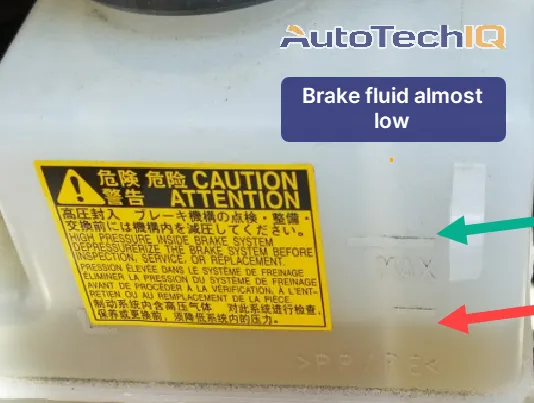
What is in brake fluid?
Brake fluid is a hydraulic fluid made of a mixture of glycols, glycol ethers, and other additives. These compounds allow it to maintain consistent viscosity across various temperatures, resist boiling, and prevent corrosion in the brake system. The specific formulation can vary depending on the type of brake fluid, such as DOT3, DOT4, or DOT5.
What is a brake fluid flush?
Brake fluid flush is the process of removing the existing brake fluid from the system and replacing it with new fluid. This process typically involves a cleaning solution that's flushed through the system.
Over time, brake fluid can accumulate moisture, reducing its boiling point and potentially leading to brake failure. Flushing ensures the system operates with clean, moisture-free fluid.
What color is brake fluid?
Fresh brake fluid is typically clear to amber in color. Over time, as it absorbs moisture and contaminants, it can darken. If the fluid becomes too dark or murky, it's a sign that it may need replacing. Regular fluid color and viscosity checks can indicate its health and if a change is due.
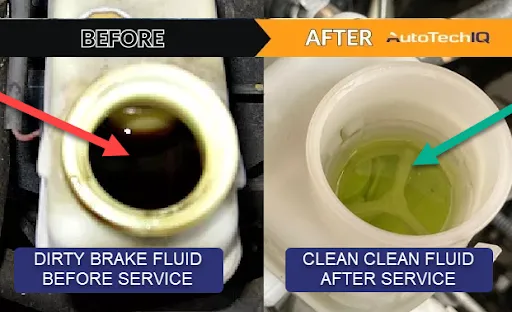
What is brake fluid for?
Brake fluid is for any vehicle that uses brakes, regardless of size. For any car, the fluid transfers the force from the brake pedal to the brake calipers or wheel cylinders, enabling effective stopping.
The fluid is designed to handle high temperatures and pressures, ensuring consistent brake response. Additionally, its properties help prevent corrosion within the braking system, ensuring longevity and reliability.
What are the most common symptoms a driver would notice when brake fluid needs service?
There are some common symptoms that vehicles show up that indicate their brake fluid is in bad condition. Let's see some of these signs.
Soft or Spongy Brake Pedal
If brake fluid gets contaminated or air enters the system, the brake pedal feels less firm. So, when you press the pedal, it'll feel loose, like it's not connected to anything. That means you might have to push it further down than usual before the brakes work, which could make it harder to stop. Consequently, this can also lead to vibrations during high-speed braking.
High Moisture Content
Over time, brake fluid can absorb moisture and get contaminated, reducing its boiling point. This leads to brake fluid boiling and vaporizing in the system, resulting in brake fade or failure. Periodic inspections can measure moisture and indicate if a fluid change is needed.
Elevated Copper Content
Old brake fluid may show higher copper levels, indicating corrosion within the brake system. Typically, brake lines or components have copper material; corrosion means this material degrades into the brake fluid. Measuring copper content during inspections helps determine the health of the liquid and the potential for internal system corrosion.
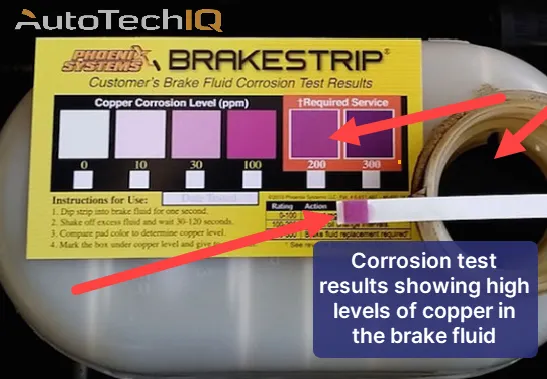
Dark or Murky Fluid
Fresh brake fluid has an amber-like color. Over time, as it contaminates, its color darkens. Dark or murky fluid means contaminants or excessive moisture, so the fluid needs replacement.
Brake Warning Light Illuminated
Some modern vehicles have sensors that detect the condition of the brake fluid. Then, if the liquid is at a low level or with a weird composition, these sensors trigger a warning. The brake warning light on the dashboard indicates a problem with the brake fluid or other braking system components.
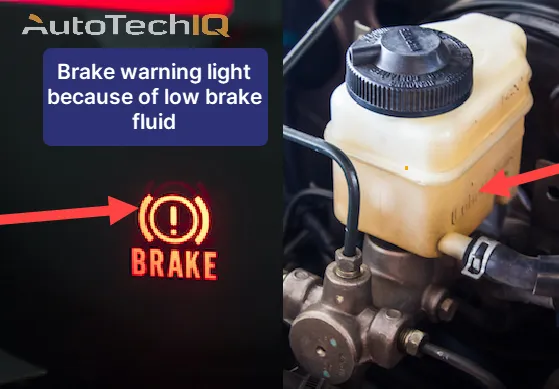
Erratic Brake Behavior
Contaminated brake fluid can lead to unpredictable brake response. This might include unexpected brake hiccups or a lack of consistent braking force; both can compromise driving safety.
Unusual Noises When Braking
If the brake fluid gets contaminated, drivers might hear weird noises when pressing the brake pedal, like a squelching sound. This often means air bubbles are moving around the brake lines within the hydraulic system.
What a Class-act Brake Fluid Service Looks Like
When customers arrive at a shop with brake fluid way overdue, it's essential to go through the importance of the fluid. Knowing how critical brake fluid is for safety, a good mechanic educates the car owner about the importance of this service.
Inspect: Mechanics start carefully examining the brake fluid reservoir and brake lines. The brake fluid might appear dark and discolored, a clear sign that it had absorbed moisture and contaminants, meaning it's old. A diagnostic tool is also used to check the fluid's moisture content, confirming how contaminated it is.
Test: A visual aid helps illustrate the significance of the issue. Mechanics should show a series of inspection images on a computer screen. These images included close-ups of degraded brake fluid, corroded brake components, and even a comparison between old, contaminated brake fluid and fresh, clean fluid.
Evaluate: The customer is typically surprised to see how much their brake fluid deteriorated and how it could impact the car's braking performance. The mechanic explains that degraded brake fluid leads to less stopping power, spongy pedal feel, and even brake failure. The main point made is that regular brake fluid replacement is essential for safety.
Diagnose: Mechanics conduct brake pedal tests with the customer's car. They ask the customer to press the brake pedal, showing them how the pedal is soft and stiff to engage. The issues are explained as being caused by air and moisture in the brake lines, which compromise stop performance.
Confirm Repair is Completed: After customer approval, the mechanic proceeds to perform a brake fluid flush; this means removing the old, contaminated fluid and replacing it with fresh, high-quality brake fluid. A comparison in color between the old and new fluid is shown to highlight the improvement. After removing any air from the fluid through a "bleeding" process, the mechanic conducts another brake pedal test. This time, the customer feels the brake pedal's firmness and improvement.
The thorough inspection, clear explanations, and visual aids focus on making customers understand that regular brake fluid replacement is a routine service. Additionally, it's a critical safety measure to keep cars in top-notch condition.
And so, class-act repair shops invest in making car owners leave their shop with knowledge, peace of mind, and safer brakes. The dedication and expertise of an auto technician committed to educating customers about their vehicle's needs is always part of the job.
Top 5 Causes of Brake System Symptoms:
Brake Fluid Contamination:
Symptoms: Dark or discolored brake fluid, reduced braking performance, spongy-feeling pedal.
Contaminated brake fluid can compromise hydraulic efficiency and lead to various braking issues.
Brake Pad Wear:
Symptoms: Squealing or grinding noises, reduced braking power, longer stopping distances.
Worn brake pads can result in poor friction and noisy operation, affecting overall braking performance.
Brake Rotor Damage:
Symptoms: Vibration or pulsation during braking, uneven braking, audible brake noise.
Damaged or warped brake rotors can cause uneven contact with the brake pads, resulting in noticeable symptoms.
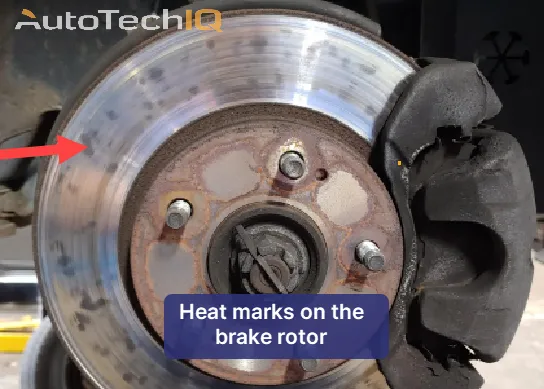
Symptoms: Uneven brake pad wear, pulling to one side during braking, burning odor.
Malfunctioning brake calipers can lead to uneven braking forces and a loss of control.
Brake Line or Hose Leaks:
Symptoms: Low brake fluid levels, soft pedal, visible fluid leaks beneath the vehicle.
Leaking brake lines or hoses can result in fluid loss, leading to reduced hydraulic pressure and braking performance.
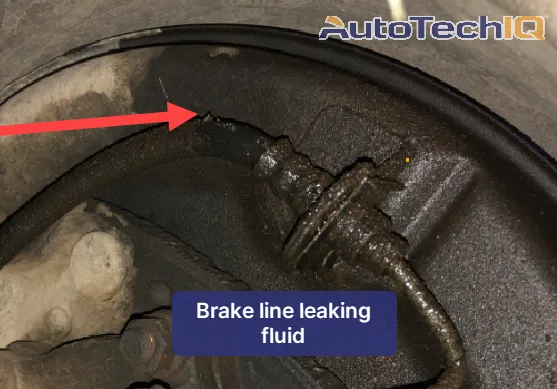
Identifying and addressing these common causes of brake system symptoms is crucial for maintaining safe and efficient braking in a vehicle.
Top 5 Brake System Fixes:
Brake Fluid Flush:
Replacing old, contaminated brake fluid with fresh fluid to maintain hydraulic efficiency and ensure safe braking performance.
Brake Pad Replacement:
Installing new brake pads to restore proper friction, eliminate noise, and improve overall braking effectiveness.
Brake Rotor Resurfacing or Replacement:
Machining or replacing damaged or warped brake rotors to eliminate vibrations and pulsations during braking.
Brake Caliper Repair or Replacement:
Addressing malfunctioning brake calipers by repairing or replacing them to ensure even brake pad engagement.
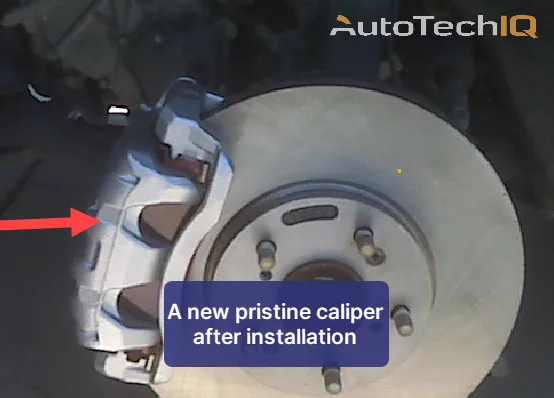
Brake Line or Hose Replacement:
Installing new brake lines or hoses to fix leaks, restore hydraulic pressure, and prevent fluid loss in the braking system.
Summary
Brake fluid is vital for the brakes. This fluid uses hydraulic pressure to push and control brake components, making them act necessarily to get the car to stop. Over time, it can absorb moisture, which reduces its boiling point and effectiveness. It can also show copper contamination, indicating internal corrosion of brake components. Symptoms of brake fluid needing service include a soft brake pedal, darkened fluid, and erratic braking. Regular inspections measuring moisture and copper content and visual and tactile checks ensure the fluid maintains optimal performance and safety in the braking system.
There's an auto shop near you delivering fair, transparent service like you've read here.
Feel free to visit our 'Shop Near You' page and search for our certified repair shops in your area. These businesses provide top-notch services while also offering expert inspections using advanced diagnostic tools. You'll witness the same level of care and attention to detail that we've highlighted in this article. These shops share our goal of ensuring that your vehicle receives the best possible maintenance. At this goal's core, your knowledge of what's happening to your car and how to maintain it is our #1 priority.






